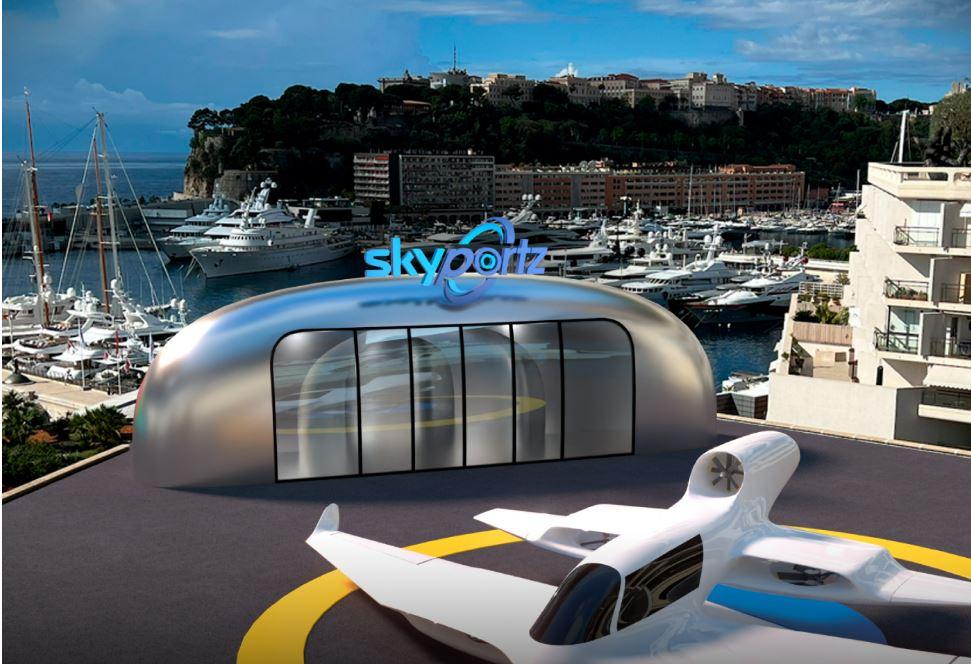
Skyportz has designed affordable, modular vertiports made of aluminum monocoque.
The advanced air mobility (AAM) industry faces a growing infrastructure funding question, with investors hesitant to pour money into vertiports with no available aircraft, unclear operating rules and an unproven business case.
The situation has opened the door for a low-risk, affordable vertiport option that could allow property developers to explore the world of AAM without risking an uncomfortable amount of capital upfront, while helping break the “nexus” between aviation and existing airports, according to Clem Newton-Brown, founder and CEO of Australian vertiport startup Skyportz.
“For practical aviation reasons and cost reasons, I’ve come to the conclusion that we need to make vertiports as affordable as possible,” Newton-Brown tells the AAM Report. “Everybody is talking about $3-per-mile ticket prices, so for a short hop it’s really not much money. The size of the pie is actually very small. We can’t have vertiport operators or owners expecting huge payments for each landing, and we have to make sure each component of the process is as lean and efficient as possible.”
As part of its vision for small and affordable vertiports, Skyportz has announced the design of a “vertiport-in-a-box” concept for modular vertiports that come in three sizes, ranging from 3 to 10 m long, which can be joined together in various configurations. The vertiport shells, manufactured out of monocoque aluminum, would range in price from around €100,000 ($110,000) to €250,000 ($275,200) according to Newton-Brown. The price would be higher when decked out with optional features like charging stations or passenger amenities.
The modular vertiports are to be fabricated in a off-site factory and can be transported to vertiport locations using a standard shipping container. To further derisk the proposition for property owners and developers–whose participation Newton-Brown believes will be crucial to building out the AAM ecosystem–he suggests the aluminum buildings could be repurposed as cafes or bars until they are ready to be activated for AAM.
“What we envisage is a beautiful little building that will still present a really cool image for the beginning of this new industry, but be at a price that the property owners will feel comfortable with,” Newton-Brown says.
Newton-Brown says he envisions vertiports at existing airports to serve as AAM hubs—where most maintenance activities would likely happen. But there will still be a need for much smaller vertiports—or vertistops, as they’re sometimes called—which in many cases would lack charging infrastructure and include just one or two vehicle landing pads.
“The very bare minimum that you would have is an area for passengers to wait and maybe some space to store the software and hardware required for activating that site,” he says. “The idea was to have a very base-level vertiport where you can add things on, like a battery charging station–but it wouldn’t be necessary.”
Commenting on the recent publication of vertiport guidance by the Australian Civil Aviation Safety Agency (CASA), Newton-Brown said the document was a “great start” for spelling out AAM infrastructure requirements. But for development work to get started, he said the government should consider publishing a land-use planning framework that could then be used by cities and municipalities to shape their own local policies.
“It would be helpful to see another document that addresses those planning and land use issues–what is the impact on neighbors, noise, privacy–all those things the CASA guidance doesn’t take into account,” he says.
Newton-Brown also described global regulators as a bit too “conservative” with their vertiport guidance to date. He said he would prefer to see electric air taxis permitted to operate with smaller final approach and takeoff (FATO) areas than conventional helicopters, which he thinks should be possible using electric-vertical-takeoff-and-landing (eVTOL) technology.
“That would be obviously preferable from a property development point of view, as using less land will make it more economical,” he says.





